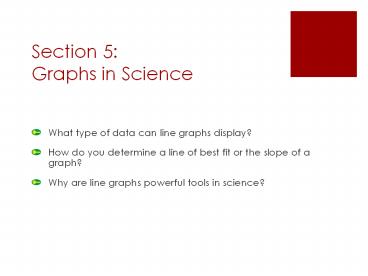Section 5: Graphs in Science - PowerPoint PPT Presentation
1 / 11
Title:
Section 5: Graphs in Science
Description:
Chapter 1 Introduction to Physical Science Section 5: Graphs in Science What type of data can line graphs display? How do you determine a line of best fit or the ... – PowerPoint PPT presentation
Number of Views:117
Avg rating:3.0/5.0
Title: Section 5: Graphs in Science
1
Section 5Graphs in Science
Chapter 1 Introduction to Physical Science
- What type of data can line graphs display?
- How do you determine a line of best fit or the
slope of a graph? - Why are line graphs powerful tools in science?
2
Why use Graphs?
- Because of their visual nature, graphs can reveal
patterns or trends that words and data tables
cannot. - Scientists commonly use bar graphs, circle
graphs, and line graphs.
3
The Importance of Graphs
Chapter 1 Introduction to Physical Science
- Line graphs are used to display data to show how
one variable changes in response to another
variable. In this experiment, the responding
variable is the time it takes for the water to
boil. The manipulated variable is the volume of
water in the pot.
4
- Open your textbooks to page 37, and lets look at
the steps of plotting a line graph. - Draw the axes
- Label the axes
- Create a scale
- Plot the data
- Draw a line of best fit
- Add a title
(horizontal axis x-axis independent variable,
vertical axis y-axis dependent variable)
(focus on general pattern, not connecting dots)
(include both independent and dependent variables)
5
Why Draw a Line of Best Fit?
Chapter 1 Introduction to Physical Science
- A line of best fit emphasizes the overall trend
shown by all the data taken as a whole.
6
Slope
- The steepness of the graph line
Slope Rise y2 - y1 Run x2
- x1 Pick any two points on the line to use the
formula to find the slope of the line.
7
Slope
Chapter 1 Introduction to Physical Science
- The slope of a graph line tells you how much y
changes for every change in x.
Slope 25 km 10 km 15 km 0.5
km/min 50 min 20 min 30 min
8
Using Graphs to Identify Trends
Chapter 1 Introduction to Physical Science
- Line graphs are powerful tools in science
because they allow you to identify trends and
make predictions. - This graphs data forms a straight line, so it is
linear
9
Using Graphs to Identify Trends
Chapter 1 Introduction to Physical Science
- Not all line graphs will have data that fall on a
straight line. - This graph is nonlinear
10
Here are some more nonlinear graphs
11
No trend
Chapter 1 Introduction to Physical Science
- Even nonlinear graphs with no recognizable
pattern provides useful information to
scientists. - It most likely means that there is no
relationship between the two variables.































